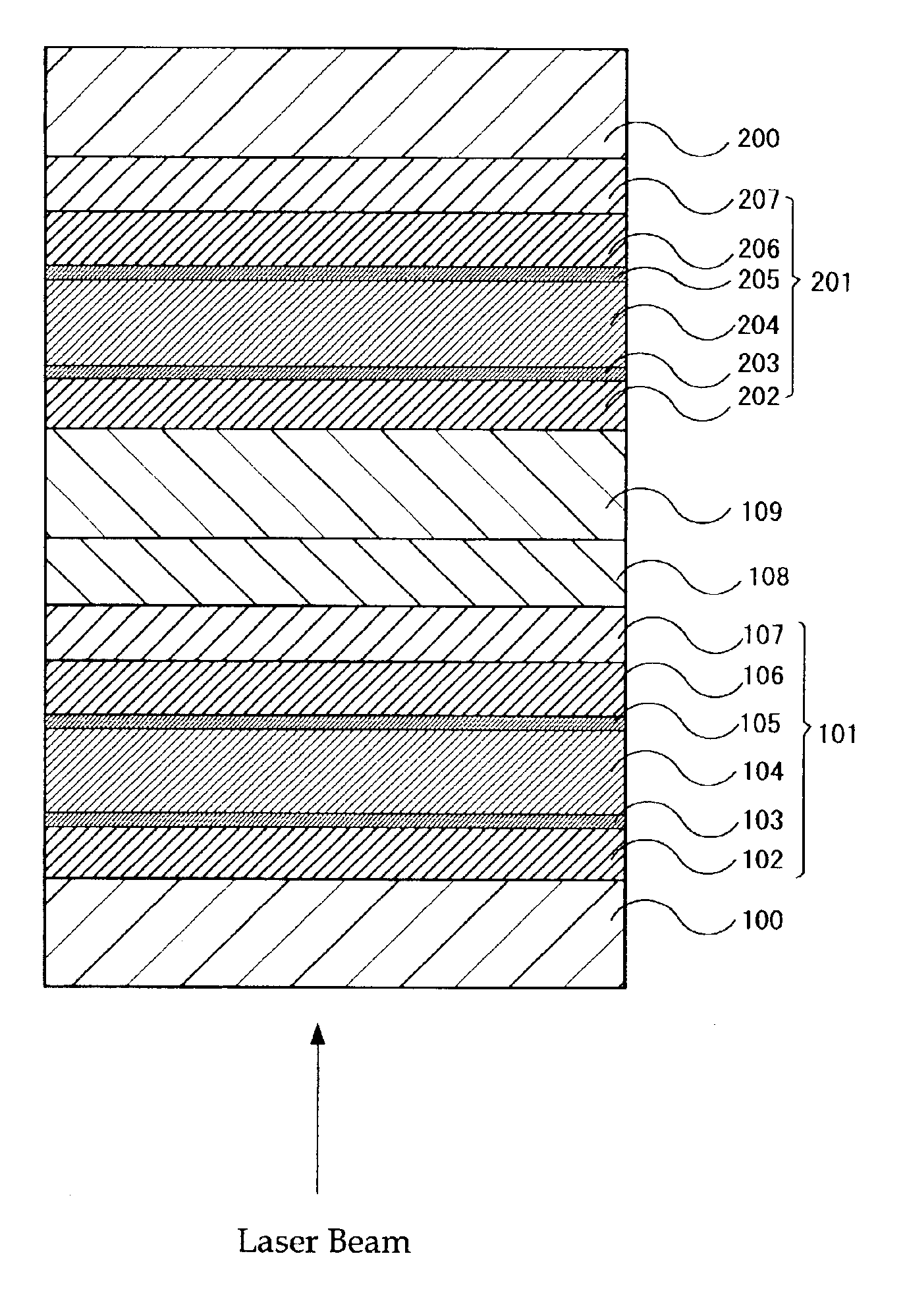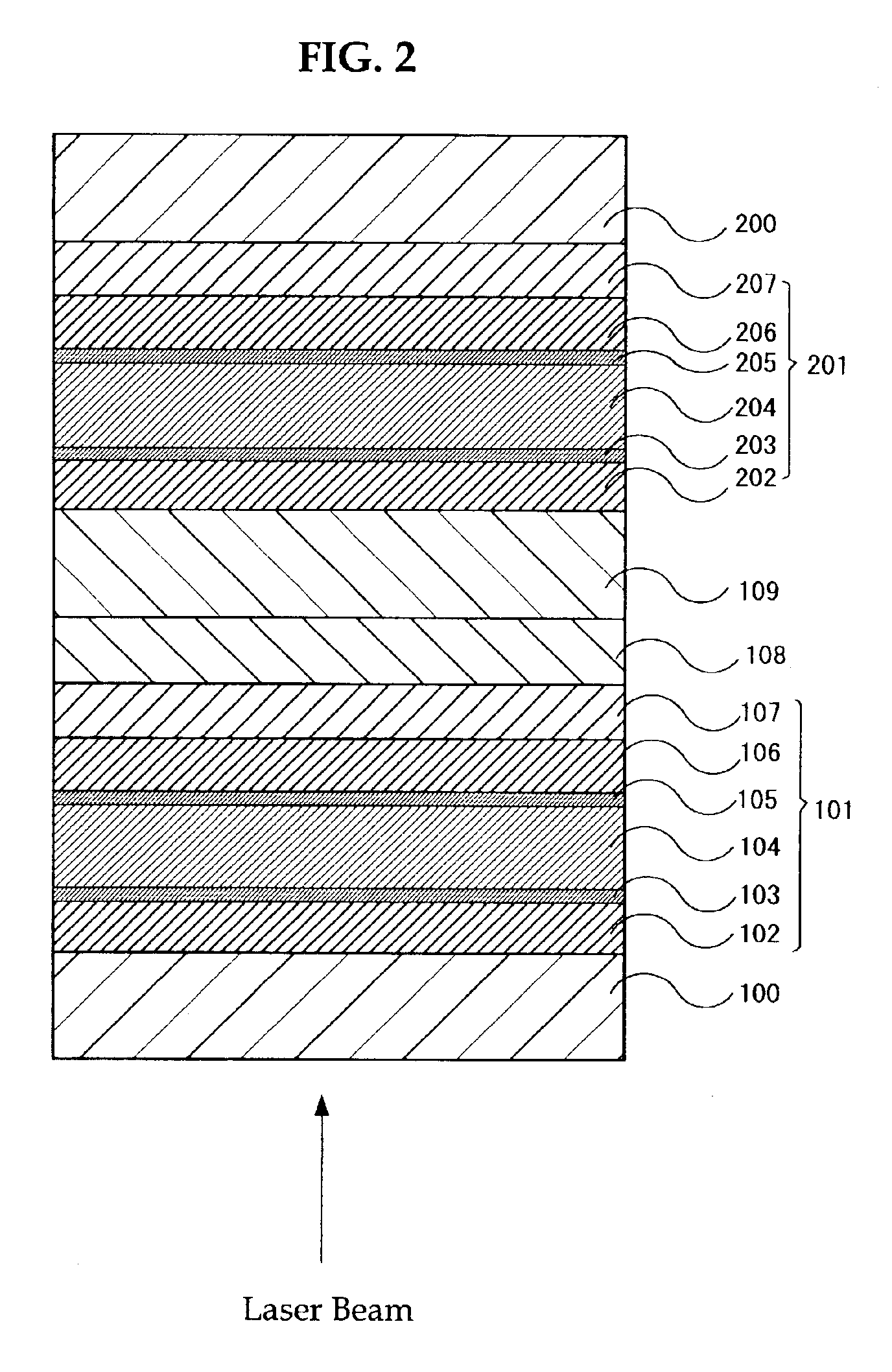Optical recording medium and optical recording process using the same
a technology of optical recording medium and optical recording process, which is applied in the field of optical recording medium, can solve the problems of overwriting distortion, noise at reproducing signals, and disadvantages of having a large value of ac/aa, and achieve the effects of improving the repetitive recording properties of light-transmittance optical recording medium, double the recording capacity, and improving the repetitive recording properties
- Summary
- Abstract
- Description
- Claims
- Application Information
AI Technical Summary
Benefits of technology
Problems solved by technology
Method used
Image
Examples
example 1
[0087]
Laser wavelength 402 nmSpotting diameter 0.3 μm (1 / e2)Recording power / erasing powerthe first recording layerstructure (7 mW / 3 mW)the second recording layerstructure (8.5 mW / 3.5 mW)Reproducing power 0.6 mWModulation code1 to 7 modulationRecording linear velocity16.5 m / sReproducing linear velocity 5.7 m / sRecording strategy(n-1) types of multi-pulses(in a case of 3T, the multi-pulse istwo), where “T” is an inversenumber of a frequency of astandard clockHead pulse width 0.4 TMulti-pulse width 0.4 TOff pulse width 0.4 T
example 2
[0088]
Laser wavelength 410 nmSpotting diameter0.52 μm (1 / e2)Recording power / erasing powerthe first recording layerstructure (7.5 mW / 3.5 mW)the second recording layerstructure (9.5 mW / 3.9 mW)Reproducing power0.55 mWModulation code1 to 7 modulationRecording linear velocity16.5 m / sReproducing linear velocity 5.7 m / sRecording strategy:(n-1) types of multi-pulses(in a case of 3T,the multi-pulse istwo), where “T” is an inversenumber of a frequency of astandard clockHead pulse width 0.4 TMulti-pulse width 0.4 TOff pulse width 0.4 T
[0089]The results of the evaluation are shown below. Table 1 shows the results of Example 1 and Table 2 shows the results of Example 2. Here, in a recording property, “⊚,”“◯” and “X” are given in the tables based on an evaluation whether or not a sample may be used in practice. In an evaluation in a first recording layer, “⊚” shows that jitter property was excellent and the jitter property was 8% or less. “◯” shows that jitter property was less than 10%, recordin...
example 3
[0094]
Laser wavelength 402 nmSpotting diameter 0.3 μm (1 / e2)Recording power / erasing powerthe first recording layerstructure (7 mW / 3 mW)the second recording layerstructure (9 mW / 3.3 mW)Reproducing power 0.6 mWModulation code1 to 7 modulationRecording linear velocity16.5 m / sReproducing linear velocity 5.7 m / sRecording strategy(n-1) types of multi-pulses (in acase of 3T, the multi-pulse istwo), where “T” is an inversenumber of a frequency of astandard clockHead pulse width 0.4 TMulti-pulse width 0.4 TOFF pulse width 0.4 T
PUM
| Property | Measurement | Unit |
|---|---|---|
| diameter | aaaaa | aaaaa |
| diameter | aaaaa | aaaaa |
| depth | aaaaa | aaaaa |
Abstract
Description
Claims
Application Information
 Login to View More
Login to View More - R&D
- Intellectual Property
- Life Sciences
- Materials
- Tech Scout
- Unparalleled Data Quality
- Higher Quality Content
- 60% Fewer Hallucinations
Browse by: Latest US Patents, China's latest patents, Technical Efficacy Thesaurus, Application Domain, Technology Topic, Popular Technical Reports.
© 2025 PatSnap. All rights reserved.Legal|Privacy policy|Modern Slavery Act Transparency Statement|Sitemap|About US| Contact US: help@patsnap.com



